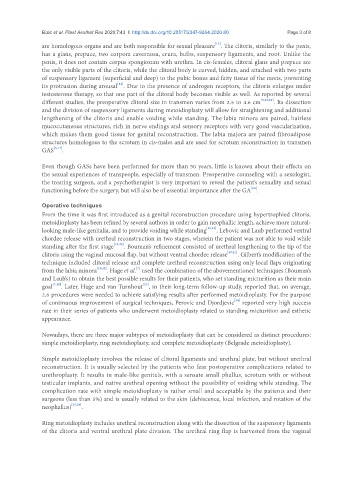Page 486 - Read Online
P. 486
Bizic et al. Plast Aesthet Res 2020;7:43 I http://dx.doi.org/10.20517/2347-9264.2020.80 Page 3 of 8
[13]
are homologous organs and are both responsible for sexual pleasure . The clitoris, similarly to the penis,
has a glans, prepuce, two corpora cavernosa, crura, bulbs, suspensory ligaments, and root. Unlike the
penis, it does not contain corpus spongiosum with urethra. In cis-females, clitoral glans and prepuce are
the only visible parts of the clitoris, while the clitoral body is curved, hidden, and attached with two parts
of suspensory ligament (superficial and deep) to the pubic bones and fatty tissue of the mons, preventing
[14]
its protrusion during arousal . Due to the presence of androgen receptors, the clitoris enlarges under
testosterone therapy, so that one part of the clitoral body becomes visible as well. As reported by several
different studies, the preoperative clitoral size in transmen varies from 2.5 to 4.6 cm [5,15,16] . Its dissection
and the division of suspensory ligaments during metoidioplasty will allow for straightening and additional
lengthening of the clitoris and enable voiding while standing. The labia minora are paired, hairless
mucocutaneous structures, rich in nerve endings and sensory receptors with very good vascularization,
which makes them good tissue for genital reconstruction. The labia majora are paired fibroadipose
structures homologous to the scrotum in cis-males and are used for scrotum reconstruction in transmen
GAS [5,17] .
Even though GASs have been performed for more than 50 years, little is known about their effects on
the sexual experiences of transpeople, especially of transmen. Preoperative counseling with a sexologist,
the treating surgeon, and a psychotherapist is very important to reveal the patient’s sexuality and sexual
[18]
functioning before the surgery, but will also be of essential importance after the GA .
Operative techniques
From the time it was first introduced as a genital reconstruction procedure using hypertrophied clitoris,
metoidioplasty has been refined by several authors in order to gain neophallic length, achieve more natural-
looking male-like genitalia, and to provide voiding while standing [10,19] . Lebovic and Laub performed ventral
chordee release with urethral reconstruction in two stages, wherein the patient was not able to void while
standing after the first stage [10,20] . Bouman’s refinement consisted of urethral lengthening to the tip of the
clitoris using the vaginal mucosal flap, but without ventral chordee release [10,21] . Gilbert’s modification of the
technique included clitoral release and complete urethral reconstruction using only local flaps originating
[7]
from the labia minora [10,22] . Hage et al. used the combination of the abovementioned techniques (Bouman’s
and Laub’s) to obtain the best possible results for their patients, who set standing micturition as their main
[23]
goal [7,10] . Later, Hage and van Turnhout , in their long-term follow-up study, reported that, on average,
2.6 procedures were needed to achieve satisfying results after performed metoidioplasty. For the purpose
[24]
of continuous improvement of surgical techniques, Perovic and Djordjevic reported very high success
rate in their series of patients who underwent metoidioplasty related to standing micturition and esthetic
appearance.
Nowadays, there are three major subtypes of metoidioplasty that can be considered as distinct procedures:
simple metoidioplasty, ring metoidioplasty, and complete metoidioplasty (Belgrade metoidioplasty).
Simple metoidioplasty involves the release of clitoral ligaments and urethral plate, but without urethral
reconstruction. It is usually selected by the patients who fear postoperative complications related to
urethroplasty. It results in male-like genitals, with a sensate small phallus, scrotum with or without
testicular implants, and native urethral opening without the possibility of voiding while standing. The
complication rate with simple metoidioplasty is rather small and acceptable by the patients and their
surgeons (less than 5%) and is usually related to the skin (dehiscence, local infection, and rotation of the
neophallus) [25,26] .
Ring metoidioplasty includes urethral reconstruction along with the dissection of the suspensory ligaments
of the clitoris and ventral urethral plate division. The urethral ring flap is harvested from the vaginal

